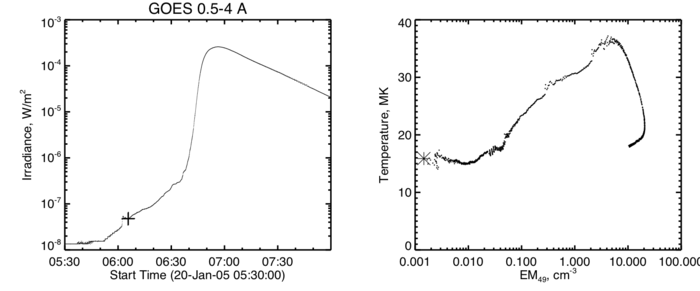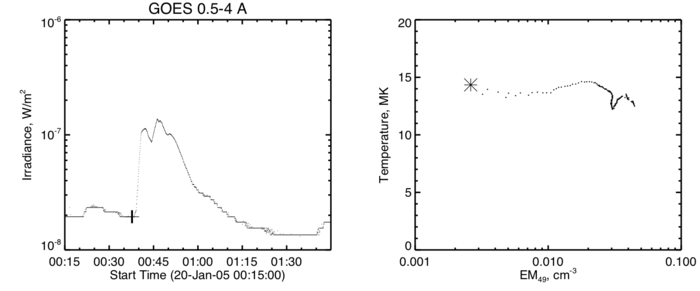Do Hot Onsets Predict Flare Magnitudes?
From RHESSI Wiki
| Nugget | |
|---|---|
| Number: | 415 |
| 1st Author: | Hugh HUDSON |
| 2nd Author: | |
| Published: | 30 August 2021 |
| Next Nugget: | Type I radio burst |
| Previous Nugget: | Confined or Eruptive? |
| List all | |
Contents |
Introduction
Nugget No. 392 revealed a universal property of solar flares that had not been much discussed, although the very basic GOES soft X-ray data show it quite clearly. This was the finding (Ref. [1]) that the very beginning of a flare - the precursor epoch prior to the impulsive phase -- invariably has an elevated temperature. This is immediately an interesting and not-yet-explained flare feature, since it does not accord with the thick-target model (1, 2, 3, etc.). Nor was it anticipated by the "standard" MHD flare model, CSHKP.
Briefly, the "hot onset" consists of the earliest epoch of detectable soft X-rays, when the volumetric emission measure is in the range log(EM) = 1-10 x 1046 cm-3. The isothermal temperature revealed by the GOES soft X-ray excess emission has an initial value typically in the range 10-15 MK, not varying systematically and particularly not showing any heating, in the sense of dT/dt > 0. The hot onset phase may continue for many tens of seconds, or even tens of minutes.
Short-term flare prediction?
The properties of the hot onset phase are not yet thoroughly understood observationally, and we have no theory for it yet. But since it precedes the main flare development, could it provide short-term warning of what is to come? If so one could trigger detailed observational programs, such as (for example) a rocket flight. This Nugget reports that a possible answer could be "Yes", though a clear answer will depend on systematic further study (which will probably raise further questions!). Studies of the hot onset remain limited, and so the motivation for this Nugget is partly just to get people working on this possibly important question.
Figure 1 shows the reason for the optimism: the spectacular X8.1 solar flare SOL2005-01-20 showed a lengthy hot onset, but with the usual temperature.

In this event the hot onset was unusually protracted, starting more than half an hour before the well-defined RHESSI 25 keV hard X-ray onset, which came at 06:36 UT. The horizontal branch of the right-hand correlation plot shows the typical lack of temperature variation during the hot onset phase. The peak temperature rises well above the hot-onset level. This plot does not continue throughout the cooling phase, but typically the GOES isothermal fits end at much lower temperatures than at onset.
As a contrast to this, Figure 2 shows a weak C-class event from the same day (SOL2005-01-20T00:47, C1.6). Here the hot onset phase lasts for only about 30 s at a slightly lower temperature. Both of the examples here use 2-sec samples from GOES; the number and spacing of the points in the right-hand panels reflects this.
Based on this single comparison, it seems that the duration of the "hot onset" flare precursor may reflect the flare magnitude. At present this thought is strictly hypothetical, to be investigated in future systematic work with the hot-onset phenomenon. The real-time method would simply consist of detecting a minimum in the GOES 0.5-4 Å flux, calculating isothermal fits as a function of time thereafter, and using the duration at 10-15 MK as the predictor.
Conclusions
This Nugget has pointed out a possible short-term flare prediction algorithm based on the common GOES soft X-ray data. This speculation should lead to a systematic study of hot onsets to see if it actually works reliably. We note that the major flare here, SOL2005-01-20T07:01 (X7.1), produced an exceptional "ground-level" cosmic ray event and wonderful coronal hard X-ray emission (Ref. [2]), as illustrated in Figure 3. This may or may not be relevant to the behavior of the hot onset phase, but of course there is considerable speculation about the triggering of flare/CMEs via coronal activity in general.
References
[1] "Hot X-ray onsets of solar flares"
[2] "Coronal γ-Ray Bremsstrahlung from Solar Flare-accelerated Electrons"
| RHESSI Nugget Date | 30 August 2021 + |
| RHESSI Nugget First Author | Hugh HUDSON + |
| RHESSI Nugget Index | 415 + |

